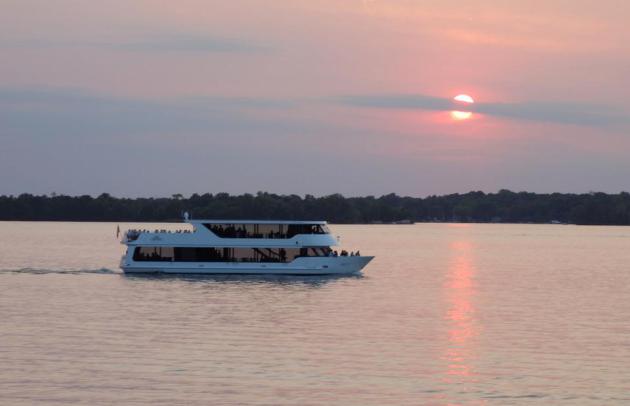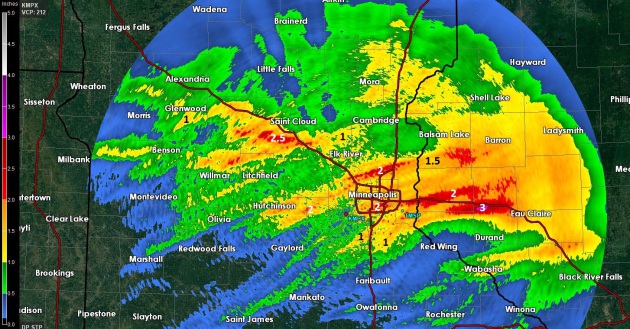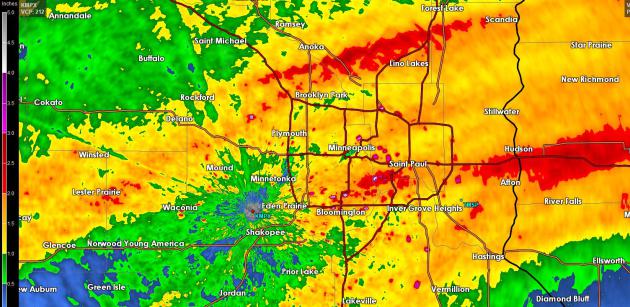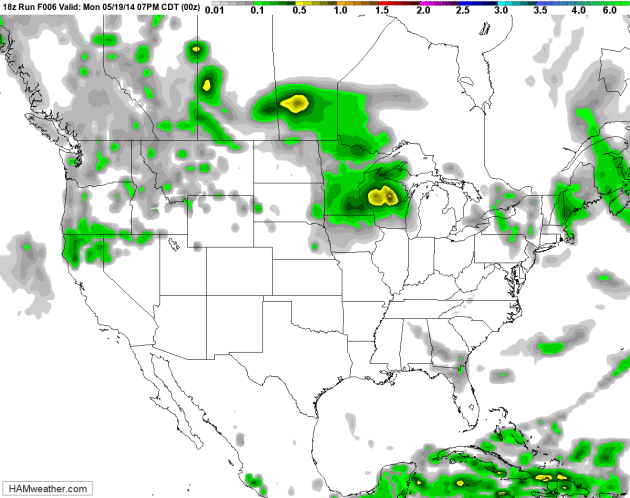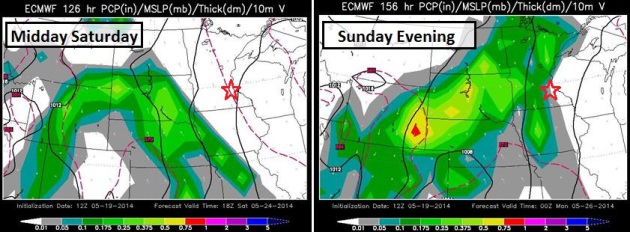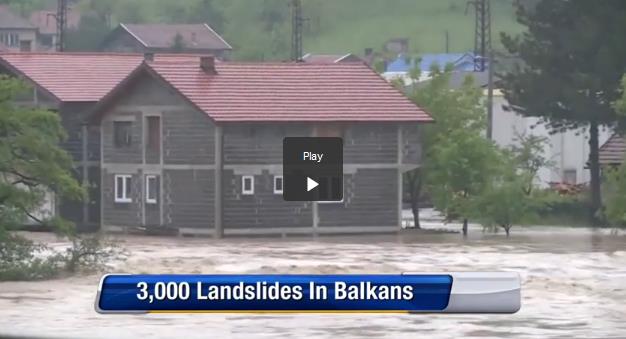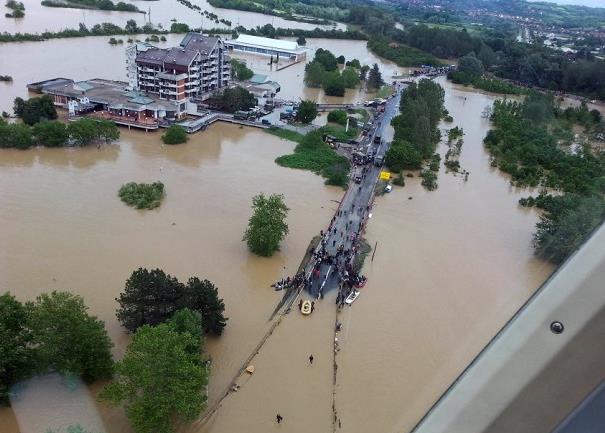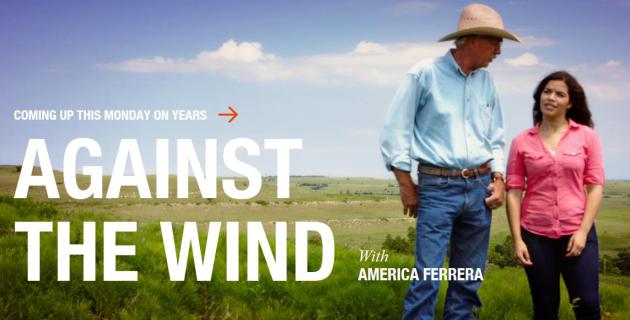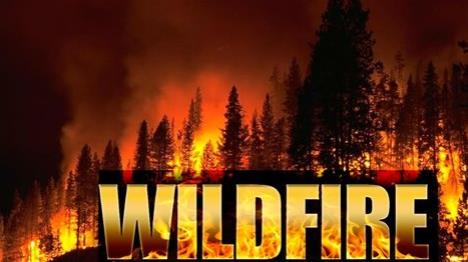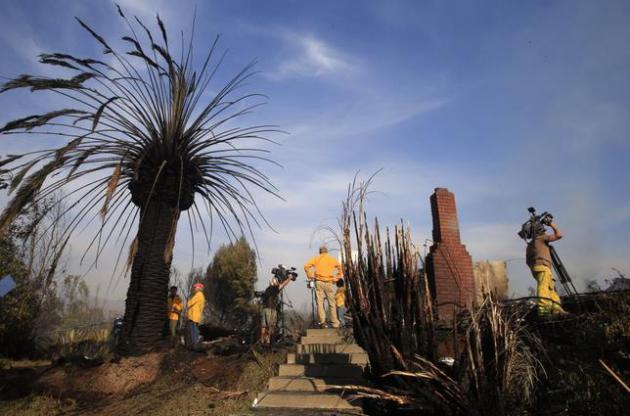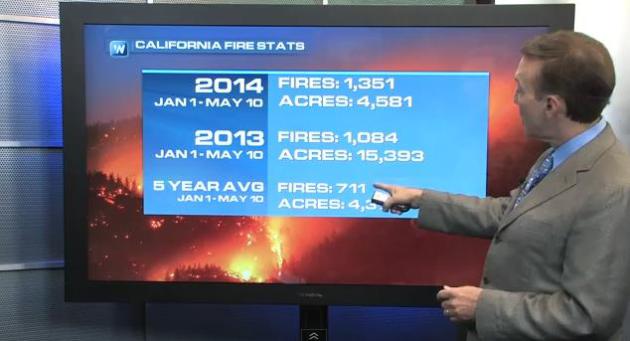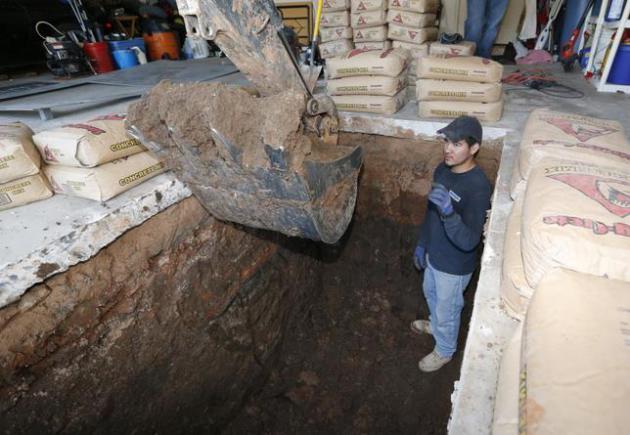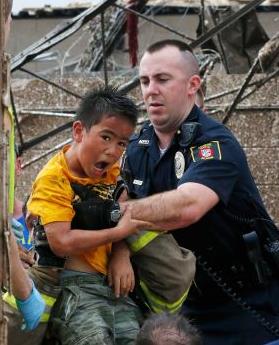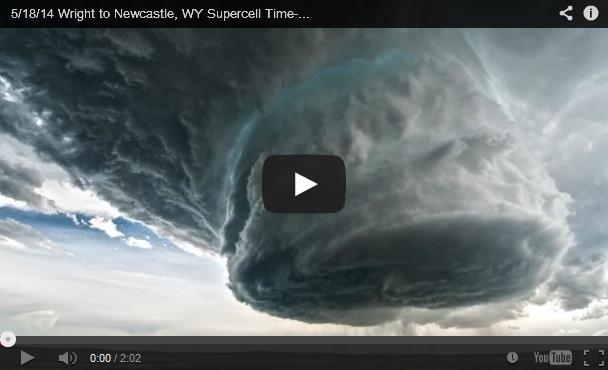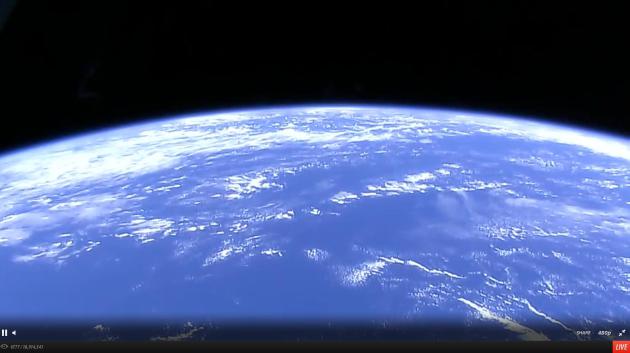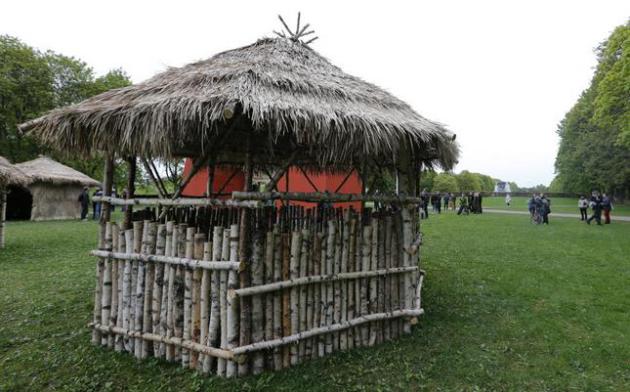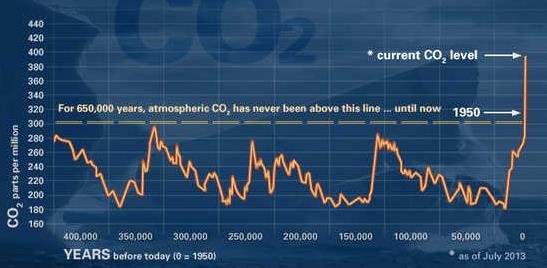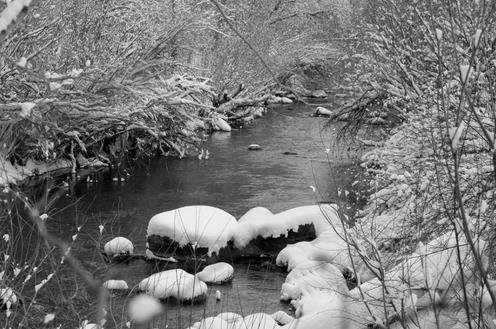Risk of 80 Degrees
30
years ago much-maligned climate models showed wet areas getting wetter,
dry areas getting even drier into the 21st century. It's amazing to see
theory showing up on a daily basis on the weather maps.
If
exceptional drought continues there's talk of another potential Dust
Bowl for the southern Plains, hopefully not on a scale like the 1930s -
the worst long-term environmental catastrophe to impact the USA.
California is facing water shortages and another severe wildfire season,
which pretty much runs year-round now. Meanwhile the Balkans just
experienced 3 months of rain in 3 days, with historic flooding and
mudslides.
The approach of an actual warm front sparked an MCS
system yesterday, a meso-convective system that soaked the area with 1-3
inch rains. No need to water the yard anytime soon. The sun comes out
today, and if we hit 80F it will be the first time since September 30,
2013. High pressure cools us off slightly by midweek, pushing storms
south and west of Minnesota.
A warming trend kicks in by late
week; highs may top 80F Saturday and Sunday. A return of southern
moisture may fuel a few random T-storms Sunday into Memorial Day.
It'll be a lukewarm rain, though.
May Soaker.
24-hour radar estimates from the Twin Cities National Weather Service
Doppler show 2" amounts commonplace across the metro, as much as 2.5"
south of St. Cloud with 3" near Eau Claire. It was roughly 3 weeks worth
of rain falling in one day as storms kept redeveloping along a
slow-moving warm front.
Watering Optional Until Further Notice.
A close-up of yesterday's derived, Doppler-indicated rainfall amounts
shows the heaviest (2"+) bands of rainfall setting up from near Elk
River and Anoka to Lino Lakes and Scandia, another band of 2"+ from the
close-in southern suburbs spreading due east on either side of I-94.
Looking More Like May.
After a warm Tuesday temperatures cool off a bit midweek, before
warming up to near 80F by Saturday and Sunday as southerly winds blow
higher dew points into Minnesota. Showers and T-storms are likely by
Sunday and Memorial Day; a few heavy downpours are likely - too early to
quantify how many hours of rain, but Saturday looks like the sunniest,
driest day right now.
GFS Solution.
Showers and T-storms push across the Midwest and Great Lakes today, a
(rare) western storm pushing a few showers into California and Nevada.
By late week a strong southerly flow from the Gulf of Mexico sparks
heavy showers and storm over the Plains (including drought-plagued
counties from Texas to Kansas); heavy T-storms reaching Minnesota and
the Upper Midwest by Sunday and Monday. Source: NOAA and HAMweather.
ECMWF Guidance.
The European model keeps showers and T-storms south and west of
Minnesota Saturday; probably the best day for the lake with highs near
80F. By Sunday heavy T-storms rumble across the state, a better chance
of storms in the Alexandria and Brainerd lakes area than the Twin
Cities. With any luck it will be scattered (heavy) T-storms, and not a
series of all-day wash-outs Sunday and Monday. Source: WSI Corporation.
Hopeful Outlook for Southern Plains.
Considering much of Kansas, Oklahoma, Texas and New Mexico is now in
exceptional drought, the 7-Day Rainfall Outlook above is encouraging,
showing some 1-3" amounts from near San Antonio to Oklahoma City,
Wichita and Lincoln. Dry weather is predicted for the Gulf Coast and far
southwestern USA. Source: NOAA.
Floods in Balkans Trigger More Than 3,000 Landslides. It's the worst flooding on record for much of the Balkans, including Bosnia and Croatia. Here's a video clip from
news4jax.com.
Flood in the Balkans - Driving Landmines To The Surface.
National Turk has the story - here's the introduction: "
Dozens
of people have already fallen to the flood victims in the Balkans. Now
facing a new danger: landmines from the civil war of the 90s are free
and floating. Several cities are under water, dozens of people were
killed in the floods. The Balkans is fighting against devastating
floods. Now the flood landmines from the war in Bosnia rinsed free.
Several exploded already..."
Could We See Another Dust Bowl?
The odds are small, but not zero. Although a widespread catastrophe
similar to the 1930s is unlikely, a smaller-scale, regional disaster is
possible over the southern Plains, where the ongoing drought has reached
"exceptional" criteria. It's already one of the 5 worst droughts for
Texas in the last 500 years, according to the state climatologist. All
it takes is a few major storms to start whipping around dust and
topsoil. At the rate we're going with one extreme after another, nothing
would surprise me. Here's a recap of today's
Climate Matters: "
WeatherNationTV
Chief Meteorologist Paul Douglas looks back at the Dust Bowl and
compares it to the historic drought currently impacting the Southern
Plains. What are the chances of it happening again?"
"
...A
drought is like a piece of sand you can never get out of your eye. It's
always there, it always reminds you every day, when you look out and
see the landscape...dying..." - from "
Years of Living Dangerously" on Showtime.
Humans Cause Vast Majority of Wildfires Nationally. This story at
azfamily.com had some interesting statistics; here's the introduction: "
More
than 72,600 wildfires are reported in the U.S. each year. Humans are
the primary cause of fires and start roughly six times more blazes than
lightning strikes in a given year, according to the National Interagency
Fire Center in Boise, Idaho, which tracked fire causes between 2001 and
2013. Human-caused fires burn more than 2. 5 million acres each year,
or nearly 4,000 square miles - an area bigger than Delaware..."
Image credit: MGN Online.
California Governor Prepares For Worst Wildfire Season. AP and
Financial Express have the story; here's a clip: "
Drought-stricken California is preparing for its worst wildfire season ever, the state's governor said Sunday. Gov.
Jerry Brown told ABC television's ''This Week'' that the nearly dozen
wildfires that caused more than $20 million in damage mark only the
beginning. The state has 5,000 firefighters and has appropriated $600
million to battling blazes, but that may not be enough in the future..."
Photo credit above: "
News media converge on a destroyed home on Mount Whitney Road in Escondido, Calif., on Friday, May 16, 2014." (Mark Boster/Los Angeles Times/MCT).
People Are 6 Times More Likely To Start Wildfires Than Lightning.
Every year an area roughly the size of Delaware goes up in smoke. So
far 2014 has brought nearly twice as many wildfires than 2013, to date,
on track for a potentially record-setting fire season. Details in
today's second edition of
Climate Matters: "
Humans
are 6 times more likely to cause a wildfire compared to lightning.
Either accidental or intentional, its going to be a long and dry fire
season across the Southwest. WeatherNationTV Chief Meteorologist Paul
Douglas goes over the forecast conditions for the drought stricken
western states. Is there a change ahead?"
Shelter From The Storm: Schools Build Tornado Safe Rooms.
The Joplin EF-5 resulted in school districts finding the money
necessary to reinforce (new) schools going up, a trend which will be
catching on not only in traditional Tornado Alley, but vulnerable
communities east of the Mississippi. Here's a clip from an interesting
article at
WRCBtv.com in Chattanooga: "...
But
Joplin’s devastation didn’t just create traumatic memories; it was also
the impetus for overhauling southwest Missouri’s disaster preparedness.
Christian County, which includes Nixa, has been particularly aggressive
in pursuing FEMA grants to build tornado-safe rooms in schools. Two
Nixa schools already have safe rooms, and three more are planned or are
under construction. Nixa was the first in the area to have shelters in
schools—the first ones were operational less than two years after the
2011 Joplin tornado—and were the first to post their building plans
online. There’s a new project underway to install all new tornado-safe
external doors in the schools. Other communities, including Joplin, have
looked to Nixa for ideas..."
Photo credit above: "
In
this Thursday, May 1, 2014 photo, Jacob Ortiz, of Thunderground Storm
Shelters, directs as the finishing touches are put on a hole for a storm
shelter installation in the garage of a residence in Oklahoma City.
Last year's deadly tornadoes, which killed more than 30 people, scared
Oklahomans in a way that previous storms had not, moving them to add
tornado shelters or reinforced safe rooms to their homes. In fact,
surging demand has overwhelmed companies that build the shelters." (AP Photo/Sue Ogrocki).
Fears Linger for Students Who Faced Deadly Tornado.
A weather-version of PTSD? I see it all the time with survivors who've
experienced a weather-related trauma. And there can be no bigger trauma
than an EF-5 tornado. Here's an excerpt from
The Houston Chronicle: "..
.Even
the slightest turn in the weather can cause anxiety and fear for the
surviving Plaza Towers students, who have been attending classes at a
refurbished junior high since the storm, Principal Amy Simpson
said. "We try not to say 'tornado' around here," said Simpson, who rode
out the storm with five other staffers in a small bathroom. "Just the
word scares them." Even the continuous outpouring of cards, gifts and
well wishes from students across the country brings fresh reminders.
"The hardest part about that is that the kids are reminded each time
someone gives something to us that their friends are gone," she said..."
Photo credit above: "Sue Ogrocki/AP. "
In
this May 20, 2013 file photo, Kai Heuangpraseuth is pulled from beneath
a collapsed wall at the Plaza Towers Elementary School following a
tornado in Moore, Okla. Heuangpraseuth will return to a new Plaza Towers
Elementary in the fall, built on the same spot where seven of his
schoolmates died last year during the storm."
How To Build A School to Withstand a Tornado. Here's a video from
NBC News that shows how focused spending on safe rooms and reinforced hallways can lower the risk of death and injury: "
Taking lessons from last year’s deadly Moore, Okla., tornado, officials are trying to determine how to better erect buildings."
Researcher Uses Past Oklahoma Tornado To Predict Future.
Are tornadoes, especially large/violent tornadoes, more likely to take
specific tracks, hitting the same communities repeatedly over time? Is
there such a thing as "favored tracks", or is it a statistical
coincidence? One researcher in Oklahoma set out to leverage GIS tools to
try and answer this question. Here's an excerpt of a story (and video)
from
NewsOn6.com in Tulsa: "...
After
the 2013 Moore tornado, Pendergrass stepped up his analysis of Oklahoma
tornados. Looking at tornado data for every square mile of the state
back to 1950, his study shows the probability of an area being hit by a
twister any given year is 1 in 1,000. But he says the calculations show
it's much higher in certain areas. "There's enough history to say these
areas are going to be hit repeatedly," Pendergrass said. The study shows
the worst spots, a 1 in 100 probability, include paths from Newcastle
to Moore to Harrah, and from Drumright to Skiatook. Those are level one
areas, because the tornados, based on the past, are also likely to be
EF-4 or EF-5s..."
Tornadoes Win Out Over TV Fairy Tales.
Viewers complaining about tornado warnings that don't impact their
neighborhoods? I definitely feel the pain of the local (Sioux Falls,
South Dakota) TV meteorologist who was trying to do the right thing,
"serve the public interest" and narrate an ongoing tornado threat. It
all comes down to relevancy and personalization - at some point new
technology will allow only the TV/cable/satellites boxes in the path of a
tornado to activate, so the rest of us can continue to blissfully watch
"Once Upon a Time" and not be bothered. Here's an excerpt from
The Spectrum: "
There’s
one constant in the news business that just about every journalist has
to learn at some point for themselves: There’s simply no way to make
everyone happy.How extreme can it get? We saw an example in the past
couple of weeks thanks to a fierce storm in South Dakota. As a tornado
touched down in Hospers, Iowa, about 70 miles from Sioux Falls, South
Dakota, the ABC affiliate there broke into programming to warn people to
take cover. Apparently, a few of the viewers took real exception to
that strategy because they missed the final moments of their favorite
program, “Once Upon A Time...”
Wyoming Supercell.
Yes, this looks like an alien landscape, like something you might find
on one of the moons of Jupiter. Boston.com has the story, and remarkable
YouTube footage.
Tsunami Conspiracy Theories in the Caribbean.
From climate conspiracies to tsunami conspiracies, the black helicopter
crowd is positive information is being covered up. Here's a clip from
an eye-opening story at
scidev.net: "
As
soon as I arrived at last week’s meeting on tsunami science here in the
Caribbean, I encountered two delegates who shared a worrying rumour
with me: “Somebody knows something about a tsunami that’s coming soon.”
That’s the way rumors work: with ill-defined but arresting claims like
this one. As usual, the rumour is based on a (distorted) reality. The
last major tsunami in the Caribbean hit in 1918 — killing 40 people and
causing US$40 million worth of damage — and because the earthquakes that
cause tsunamis sometimes adhere to decades-long cycles, some scientists
here think that another one must be due..."
Image credit: Espen Rasmussen / Panos.
HDEV Allows Us Detailed Views Of Our Planet From Space.
One of the few remaining (must-attempt) things on my bucket list is to
get into low-Earth orbit. I'm hoping the prices come down in the coming
years and I won't need to sell a kidney to see weather (from above). In
the meantime
gizmag.com
has a story about a near real-time stream of HD video coming from
NASA's ISS, the International Space Station. Here's a clip: "As of April
30, NASA has been running its High Definition Earth Viewing Experiment
(HDEV) which, as well as testing certain aspects such as a camera's
ability to survive the radiation levels present in low-Earth orbit, is
giving viewers the breathtaking experience of observing their planet in
exquisite detail from space. The video feed is streamed from one of four
high-definition cameras mounted on fixed positions of the
Columbus External Payload Facility of the ISS..."
* the live stream from NASA is
here, courtesy of UStream.
Human Zoo Hopes To Challenge Norway's Image on Racism.
Reuters has the curious story - here's a clip: "
Displaying 80 people in a human zoo in Oslo's most elegant park, two artists hope their "Congo Village" display will help erase what they say is Norwegians' collective amnesia about racism. Re-enacting a similar display from 1914, Lars Cuznor and Mohamed Ali Fadlabi say Norway,
one of the richest nations in the world, with a reputation for
tolerance, has only suppressed its intolerance, especially around the
time of Saturday's national day..."
Photo credit above: "
A
hut on display, during the opening of the Congo Village exhibition, in
Oslo, Thursday, May 15, 2014. One hundred years ago, an exhibition
entitled 'Congo Village' consisting of 80 people of African descent put
on display in a "huma zoo" debuted in Oslo, Norway. The exhibition is
being reenacted by two artists attempting to draw attention to the event
that was largely ignored in mainstream culture." (AP Photo/NTB Scanpix, Lise Aserud).
Best Commencement Speeches, Ever.
NPR has done a good job of making some truly amazing speeches available, and easy to search for your favorite speakers/topics.
Aero-X Hoverbike Set To Take Off in 2017.
A combination of bike, motorcycle and hovercraft looks like great fun,
if you have more money than sense. That said, I have no common sense. I
want one. Here's a clip from
Gizmag: "
That
most long-awaited form of transport may finally be arriving with
California-based Aerofex announcing that it'll be launching its Aero-X
hoverbike in 2017 at an estimated price of US$85,000 (+CPI). The company
is already accepting refundable deposits of $5,000 on its website, with
first flights scheduled for 2016. The Aero-X is designed to carry two
people up to a height of 3 m (10 ft) above the ground and reach speeds
of up to 72 km/h (42 mph)..."
Photo credit: "
It's expected to run for about 1 hour and 15 minutes on a full tank of fuel." (Photo: Aerofex)
Why You Shouldn't Swallow Pool Water.
Remind me not to jump, feet-first, into a warm, brackish pond anytime
soon - or accidently swallow water from the neighborhood swimming pool.
Here's an excerpt of a story at LiveScience and
Huffington Post: "...
Naegleria, a rare but deadly brain-eating amoeba,
is another threat, which tends to lurk in warm, stagnant water. To
avoid contracting the amoeba, swimmers should avoid jumping feet first
into warm ponds, particularly if the summer is really dry, Ohl said.
When someone jumps feet first into a pond, water can get into the nose,
which can act as a channel through which the amoeba can enter the brain."
First Drinkable Sunscreen Created. Just when you thought you had seen everything, along comes this article at
The Telegraph.
It makes me thirsty just thinking about the next warm front. Wait, if
you could mix this with an energy drink then you'd REALLY have
something! Here's an excerpt: "
The days of asking a friend to rub
suncream on your back or waiting for your lotion to "sink in" to avoid a
sandy situation could be numbered, as a US skincare company claim to
have created a drinkable suncream. Osmosis Skincare claim their product,
named Harmonised H20 UV protection, can provide sun protection up to
factor 30. Those who make the product, which is available to buy, claim
that once the elixir is ingested, molecules of the product vibrate on
the skin to cancel out 97 per cent of UVA and UVB rays..."
Photo credit above: "
Safe sunbathing may become hassle free with the development of drinkable suncream."
Photo: Fotolia.
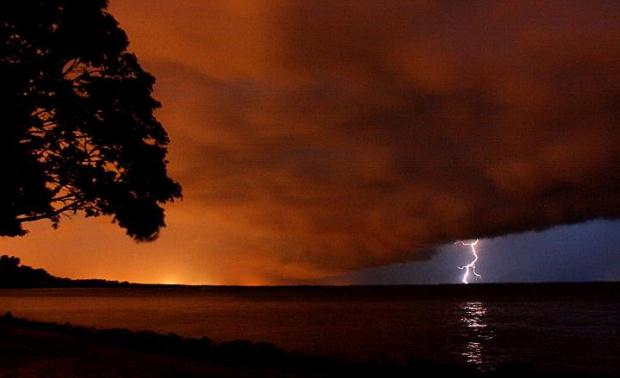
* lightning photo above courtesy of Brad Birkholz.
Climate Stories...
European Space Agency's CryoSat-2 Satellite: Antarctica Shedding 160 Billion Tons of Ice A Year. Here's a clip from
Daily Kos that I wasn't aware of: "...
Antarctica
is shedding 160 billion tonnes a year of ice into the ocean, twice the
amount of a few years ago, according to new satellite observations. The
ice loss is adding to the rising sea levels driven by climate change and
even east Antarctica is now losing ice. The new revelations follows the
announcement last week that the collapse of the western Antarctica ice sheet has already begun and is unstoppable, although it may take many centuries to complete..."
The Melting Isn't Glacial.
Are we at a tipping point - or is the news coming out of West
Antarctica and Greenland more "alarmist hype"? Are you willing to roll
the dice? Here's a clip from a story at
The New York Times: "...
The
ice sheets of Antarctica and Greenland together possess about 100 times
as much ice as all of the mountain glaciers combined, but contribute
only slightly more to the sea level rise: 310 billion tons a year, Dr.
Scambos said. That is because most of the mountain glaciers lie in areas
where temperatures are closer to the melting point than they are in
Greenland or Antarctica, and so slight warming tips them to melting.
Greenland, with 10 percent of the world’s ice, has enough to raise sea
level by 23 feet. “I still think Greenland is the most important thing
to watch for this century,” Dr. Scambos said..."
Photo credits above: "Muir
Glacier at Glacier Bay National Park and Preserve in Alaska is among
the many worldwide that are disappearing. Muir, left, as seen in August
1941, and photographed in August 2004." Credit W. Field; B. Molnia/U.S.G.S. via Glacier Photograph Collection.
Climate Change: Get Ready or Get Sued.
What are the liability implications of climate change, specifically the
trend toward heavier summer downpours and more extreme flooding east of
the Mississippi? The insurance industry and lawyers far and wide will
be keeping a close eye on this case in Chicago's suburbs. Here's an
excerpt of a story at
The Washington Post: "...
This
is a new kind of storm associated with climate change,” Tom LaPorte,
spokesman for the Chicago Department of Water Management, told Medill Reports on
day two of the April flood. Extreme flooding is part of a pattern that
has emerged in the last two decades, according to Illinois State
climatologist Jim Angel. Now a major insurance company is suing
Chicago-area municipal governments saying they knew of the risks posed
by climate change and should have been better prepared. The class-action
lawsuits raise the question of who is liable for the costs of global
warming..."
YouTube video credit above: "
Flooding
of the Des Plaines River in Des Plaines , IL. the weather overcast and
severe thunder storms. Over 5 inches of rain in less than 12 hours.
Temps in the 60s." Filmed by Ed Pilar for
8desplaines.com.
The People of Miami Know About Climate Change. We're Living It.
You no longer need a hurricane or even a coastal storm or thunderstorm
downpours to get flooding in Miami. Now it often floods at high tide, a
rising tide at that. Here's an excerpt from a story at
The Guardian: "...
People
in Miami Beach are living climate change," said David Nolan, a
meteorology and physical oceanography professor at the University of
Miami. "They're on the frontline." The people of Miami Beach didn't need
the National Climate Assessment to tell them low-lying south Florida is
"exceptionally vulnerable to sea level rise". The city is already
spending $206m to overhaul its drainage system. The day after the White
House released its climate change report, Miami-Dade County's commission
passed a 6 May resolution that calls on planners to account for sea
level rise. Local officials across the four counties of south Florida
are making similar moves. Almost anyone who lives in south Florida has a
nagging fear about climate change. It's both abstract and, at times,
very real..."
Photo credit above: "
Bozon Jeremie, a
tourist from France, crosses a flooded intersection during high tide in
Miami Beach, Fla., Nov. 6, 2013. A new scientific report on global
warming released in 2014 by the National Climate Assessment named Miami
as one of the cities most vulnerable to severe damage as a result of
rising sea levels." (Angel Valentin/The New York Times).
Global Warming Responsible for Increased Wildfires in California? If this is, in fact, a "natural cycle" it's one heck of a coincidence. Here's an excerpt from a story at
Headline & Global News: "...
Global
warming also contributes largely to mega-fires, which occur when
multiple wildfires combine together to form a larger, deadlier blaze,
and the size of these fires makes it difficult for containment. In the
last decade, the occurrence of such fires has increased in frequency.
According to Global Change,
about 6.4 million acres have been burned per year on an average since
2010, amounting to a 3.5 million acres increase since the 1980s. Many
studies have also highlighted that global warming also increases
wildfires indirectly. This climate change leads to other factors that
promote wildfires, such as drought and insect outbreaks..."
File Photo credit: "
Smoke
plumes rise behind the Marine Corps Camp Pendleton entrance Friday, May
16, 2014, in Oceanside, Calif. San Diego County officials said Friday
five wildfires have been 100 percent contained. Still, crews were
focusing efforts on two large fires — one in the city of San Marcos and
two blazes at the Marine Corps' Camp Pendleton." (AP Photo/Gregory Bull).
Snowfall and Global Warming: Less Snow May Cause Rivers to Go Dry.
International Science Times has a good recap on new research; here's an excerpt: "...
Climate
change due to human activity has caused temperatures around the world
to increase. These effects have been felt on snow-affected catchments,
where a temperature rise of even two degrees Celsius has significantly
reduced the amount of snow falling in these parts. The new research
suggests that the amount of water in rivers will be reduced as a result
of the decrease in snow..."
Photo credit above: "
Snowfall
contributes water to nearby water sources, but as global warming
reduces the occurrence of snow, these rivers may go dry." (Photo: Paul Harbarth, CC BY 2.0).
"Cosmos" Explains How Global Warming Threatens Civilization As We Know It.
Mother Jones has the story and interview - here's an excerpt of an article, a quote from host Neil deGrasse Tyson: "..
In
one respect, we're ahead of the people of ancient Mesopotamia. Unlike
them, we understand what's happening to our world. For example, we're
pumping greenhouse gases into our atmosphere, at a rate not seen on
Earth for a million years. And there's scientific consensus that we're
destabilizing our climate. Yet, our civilization seems to be in the grip
of denial, a kind of paralysis. There's a disconnect between what we
know, and what we do. Being able to adapt our behavior to challenges is
as good a definition of intelligence as any I know..."
Image credit: FOX, National Geographic.
Letter: "Climate Change is Local".
Who cares about the melting ice caps? When they start impacting your
local weather you may pay a little more attention. Here's an excerpt of
an Op-Ed at Fargo's
INFORUM: "
Why
should I care about global climate change? I live in Fargo. I’ve never
been to the North Pole or South Pole, and I don’t plan on traveling
there, so the melting of the polar ice caps has no effect on me. The
truth is, the effects of climate change extend far beyond the melting of
the polar ice caps. Global climate change affects many climates around
the world, and will produce changes that will be noticeable in North
Dakota and even Fargo...."
